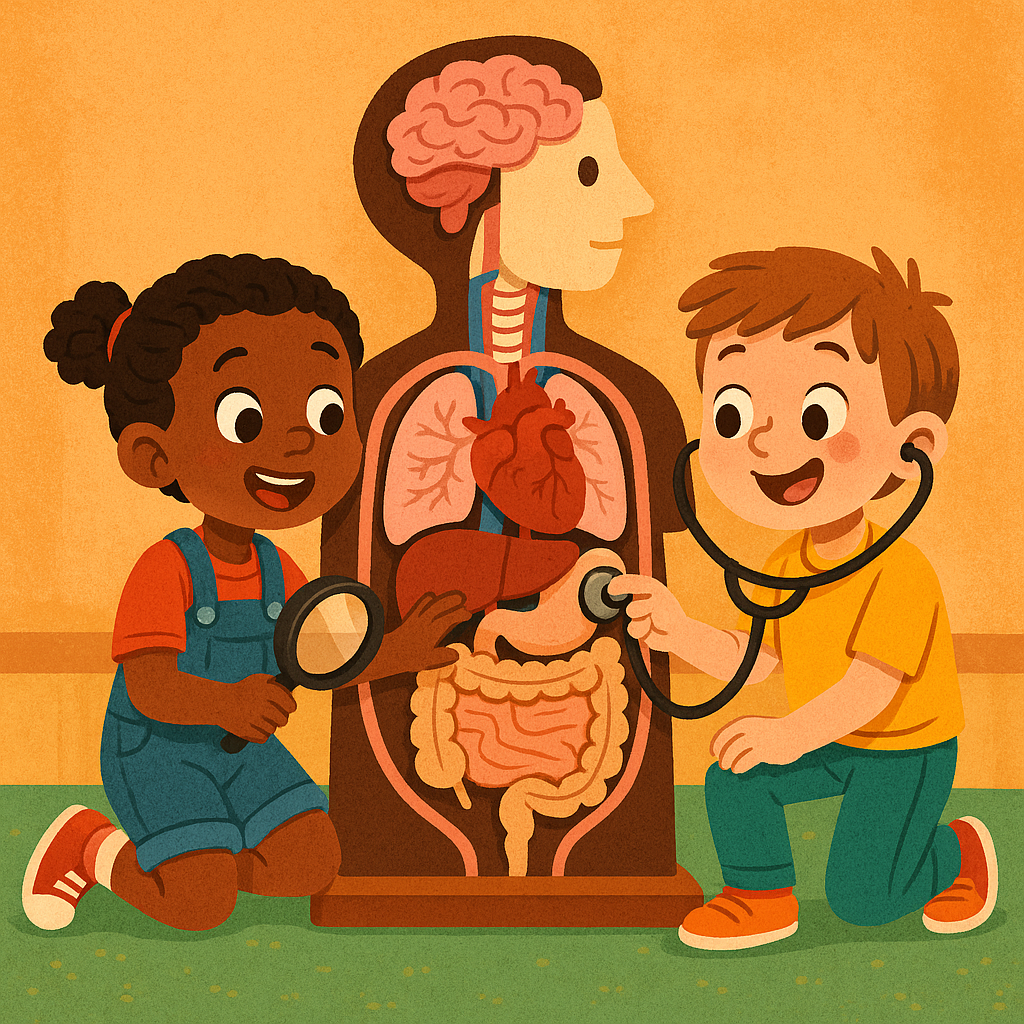1. Mirror Dance: “Head, Shoulders, Knees & Toes” 🪞🕺
🎯 Target Developmental Skills
- Body-part vocabulary & early language
- Gross-motor coordination & balance
- Social-emotional connection (face-to-face mirroring)
🧰 Materials
- Full-length or tabletop mirror
- Household alternatives: shiny baking sheet, turned-off TV screen, phone selfie camera, or a stainless-steel pot lid
👣 Step-by-Step
- Sit or stand with baby facing the mirror. Smile big! 😊
- Sing “Head, Shoulders, Knees & Toes,” gently touching your own body parts.
- Guide baby’s hands to their head (hands-over-hands) as you name it. 🫶
- Pause after each part; let baby glance at the mirror and back to you.
- Slow the song, adding silly faces or gentle kicks for “toes.” 👣
- Repeat 2–3 times, gradually encouraging baby to touch or point independently.
- Modification for older toddlers (18-24 m): Ask, “Where’s your elbow?” and let them show you before the song continues.
- For younger babies (0-6 m): Simply name body parts while moving their arms/legs in rhythm.
🤗 Parent/Caregiver Guidance
Keep your tone sing-songy and enthusiastic—babies tune in to musical prosody! Cheer small attempts: “Yes, that’s your nose! Boop! 👃” Notice eye-contact in the mirror and echo their expressions. If attention drifts, shorten verses or add gentle tickles to re-engage.
🧠 Why This Helps (Everyday Explanation)
Labeling body parts builds early vocabulary, and matching words to movement strengthens the brain’s “body map” (proprioception). Seeing both of you in the mirror also boosts self-recognition and social bonding.
📚 Research Foundation
- Montessori “movement matters” principle: pairing language with purposeful motion enhances memory.
- Piaget’s sensorimotor stage (0-2 yrs): learning happens through physical interaction.
- Meltzoff & Moore (1997): babies imitate facial/body movements, strengthening social cognition.
2. “Heartbeat Drum” ⏳❤️
🎯 Target Developmental Skills
- Early science curiosity (cause & effect)
- Auditory discrimination & rhythm
- Fine-motor grasping & handing over objects
🧰 Materials
- Empty oatmeal canister or plastic container with lid (makes a drum)
- Light scarf or towel
- Household alternatives: upside-down saucepan, cardboard box, tightly closed coffee tin, or a shoebox
👣 Step-by-Step
- Hold baby close; place their hand on your chest. Whisper, “Listen… that’s my heartbeat!” ❤️
- Gently tap the drum — lub-dub… lub-dub — matching your natural pulse (~60–80 bpm).
- Invite baby to bang or pat the drum. Celebrate any sound they make! 🥁
- Cover the drum with the scarf; ask, “Where did the sound go?” Lift to reveal and bang again (object permanence peekaboo).
- Alternate fast vs. slow beats. Describe: “Now it’s running fast! 🏃”
- Place drum on floor for crawling baby; encourage two-handed pats to build bilateral coordination.
- For toddlers 18-24 m: Let them check your pulse at the wrist, then try to match the beat themselves.
- For younger infants: You do the drumming while they explore texture of the scarf.
🤗 Parent/Caregiver Guidance
Exaggerate facial queuing: wide eyes when the beat “disappears,” soft “ooo!” when it returns. Use descriptive language (“slow, steady, fast”) and invite turn-taking: “Your turn to drum, my turn to drum.”
🧠 Why This Helps
Feeling and hearing a heartbeat introduces basic biology (“inside noises”). Drumming synchronizes auditory and motor pathways, laying early groundwork for timing—important later for speech and coordination.
📚 Research Foundation
- Trevarthen’s theory of musicality (1999): infants naturally respond to rhythmic human sounds.
- Study by Provasi & Bobin-Bègue (2003): rhythm activities improve temporal processing in toddlers.
- Montessori sensorial approach: concrete, hands-on exploration builds abstract understanding.
3. “Tiny Taste Testers” 👅🍋
🎯 Target Developmental Skills
- Sensory exploration (taste & texture)
- Facial-muscle practice & oral-motor control
- Language: descriptive words (“sour,” “sweet”) & early sign language for “more”/“all done”
🧰 Materials
- Small samples of baby-safe foods in four tastes: sweet (banana), salty (plain cracker), sour (lemon slice), bitter (unsweet cocoa crumb)
- Bib or wipe cloth
- Household alternatives: sweet – cooked carrot, salty – cheese shred, sour – plain yogurt, bitter – chopped spinach leaf
👣 Step-by-Step
- Seat baby securely (high chair). Show each food, naming: “This is sweet banana.” 🍌
- Offer a pea-sized taste; pause to let them react. Mirror their expression—“Oooh sweet!”
- Clean palate with a sip of water or breast-/formula in between.
- Proceed to salty, sour, then bitter. Keep facial expressions playful, not negative, to avoid bias. 😋
- Encourage baby to sign or say “more” or “all done.” Model the motions/words.
- For toddlers, place samples in divided tray; prompt them to sort “yummy vs. yucky.”
- Modify for allergies: substitute safe-tested foods and introduce one new food per day.
- Younger infants (4-6 m just starting solids): stick to two tastes and tiny purées.
🤗 Parent/Caregiver Guidance
Stay upbeat—“Wow, that lemon makes your lips pucker!” Label feelings: “Sour can feel surprising.” Encourage exploration even if faces look unsure. If baby refuses, calmly move on; no pressure.
🧠 Why This Helps
Early exposure to varied flavors reduces picky eating later and strengthens oral-motor muscles critical for speech. Naming tastes links sensory input to language, building neural connections between mouth and brain.
📚 Research Foundation
- Beauchamp & Mennella (2011): infants exposed to diverse flavors accept more foods in preschool.
- Sensory Integration Theory (Ayres): rich multi-sensory experiences foster adaptive responses.
- Baby-Led Weaning studies (Rapley, 2015): self-feeding promotes fine-motor & eating autonomy.
.svg)
